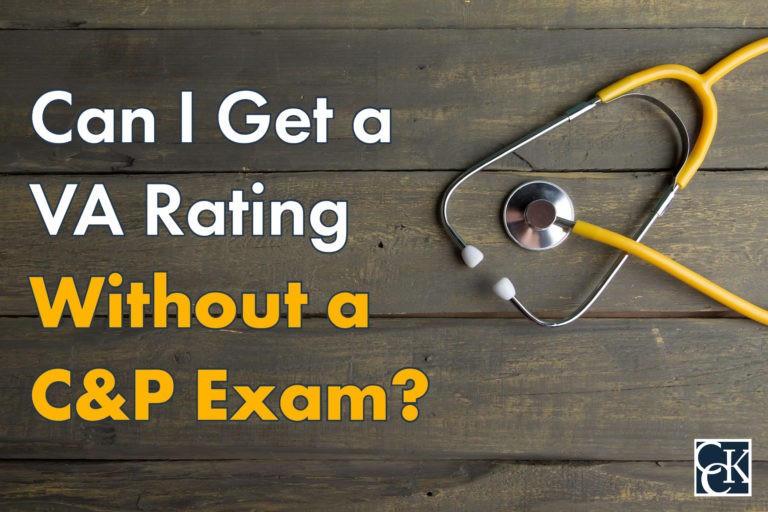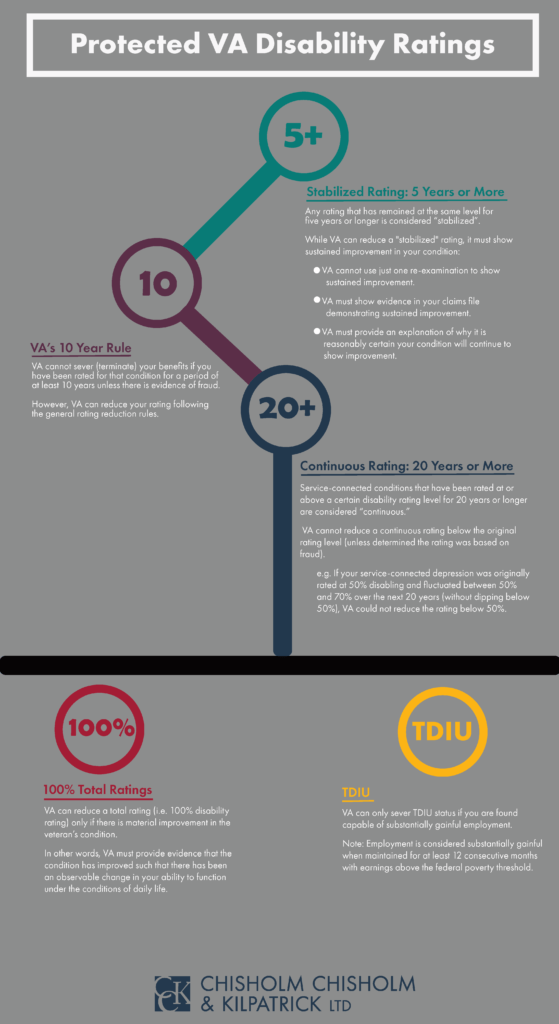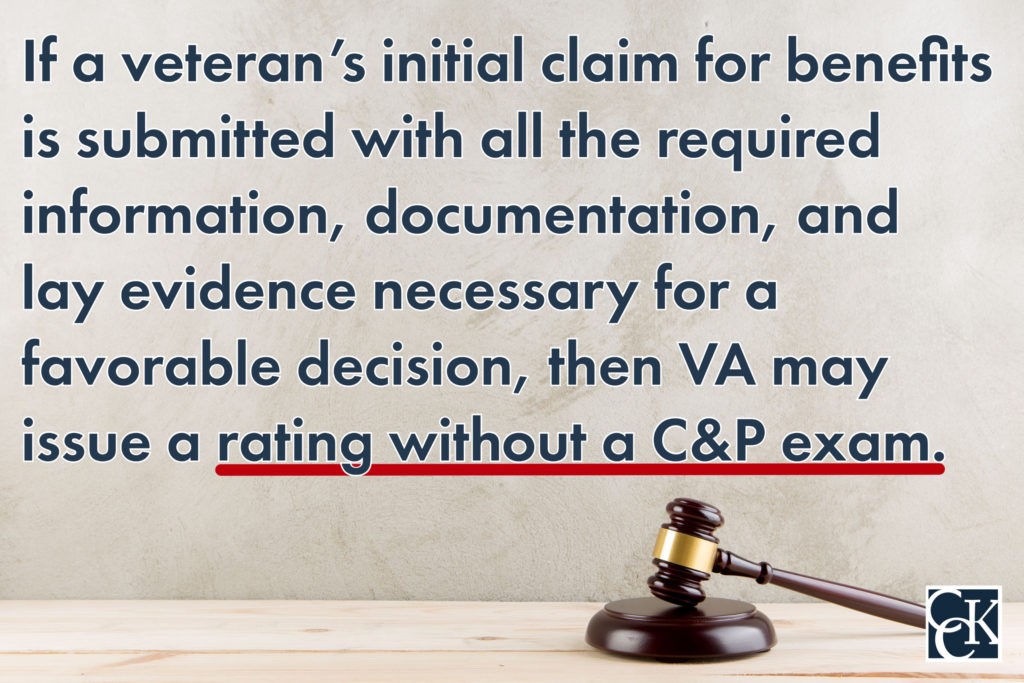Can I Get a VA Rating Without a C&P Exam?

CCK Law: Our Vital Role in Veterans Law
Compensation and Pension (C&P) exams play an integral role in the VA disability claims process. Oftentimes, veterans are scheduled for numerous exams throughout this process. Many veterans grow frustrated at the repetitive exams—which then begs the question, can veterans get a VA rating without a C&P exam?
Who Must Attend C&P Exams?
Any veteran who files a claim may be asked to attend a C&P exam. Every veteran who does not have a permanent and total rating is subject to C&P reexaminations. This essentially means that veterans, even if service-connected, who do not have this rating may be asked to attend a C&P exam.

When Are C&P Exams Needed?
VA will call for an exam when more information about a veteran, veteran’s condition, or the relationship between a veteran’s condition and their service is required to decide a claim.
While some conditions may be able to be examined by a general physician or health care practitioner, others need an expert or specialist to examine the condition. As such, VA will need to ensure that the examiner has the proper advanced medical training to complete the exam. In some cases, some exams may look at multiple conditions at once.
Essentially, exams are most often called for to:
- Analyze any discrepancies with the diagnosis
- Verify that a veteran’s condition is service-connected or establish the link between the condition and the veteran’s service (also known as a nexus)
- Supply further medical information regarding the veteran’s condition or symptoms to ensure the rater has adequate information
What Triggers a C&P Reexamination?
Though many exams are pre-scheduled at specific intervals are time, there are instances in which a C&P may be “triggered” after the initial claim. Specifically, VA is more likely to schedule an exam in the following instances:
- Changes in symptoms, usually noted in medical records;
- New VA claim has been filed for an increased rating;
- New VA claim(s) filed for condition(s) secondary to an already service-connected condition.
If VA notes a change in symptoms in the medical record, VA policy requires that a pre-exam review occur prior to the scheduling of the exam. This is done to confirm that a C&P exam is actually necessary and that the veteran meets the criteria for a new exam.
The pre-exam ensures that VA does not waste money on an exam when it is not needed. Typically, it consists of VA reviewing the veteran’s records to determine if the veteran’s symptoms are consistent and justify the current disability rating that the veteran has been assigned. A pre-exam might be done prior to an exam to reduce or to increase a veteran’s rating. Most commonly, however, exams are ordered to reduce a veteran’s rating.

Does VA Make Mistakes When Ordering Examinations?
A review conducted by the Office of the Inspector General (OIG) for VA found that VA employees “did not consistently follow policy to request reexaminations only when necessary.” In a sample of 300 cases that had reexaminations in a window from March 2017 through August 2017, the report found that employees requested unwarranted medical reexaminations in 111 cases.
With analysis, the report estimates that employees requested unwarranted examinations in 37 percent of all cases during these five months. Specifically, employees requested examinations in cases where a VA rating could be issued without a C&P exam or remain unchanged:
- The veteran was over the age of 55 and the exam was not warranted by any unusual circumstances, OR
- The veteran had a permanent and total disability that was not likely to improve, OR
- The veteran had a disability without substantial improvement over five years, OR
- There was sufficient evidence in the claims file to continue the current disability rating, OR
- Examining a particular condition, regardless of outcome, would not change the veteran’s overall combined rating for multiple disabilities, OR
- The veteran’s rating was evaluated at 10 percent or less, OR
- The veteran’s rating was already at the minimum level for the condition.
How Much Does VA Spend on Unwarranted Exams?
That same report listed above estimated that VA spent roughly $10 million on unwarranted exams. Of this $10 million, $5.3 million was spent on exams with Veterans Health Administration clinicians and $4.8 million was spent on exams through VA contractors.
Additionally, the report speculated that VA would waste $100.6 million on unwarranted reexaminations between 2017 and 2021 if employees did not stop requesting re-examinations when they were not necessary.
The OIG report also found that out of 19,800 unwarranted re-examinations, 15,500 did not have a pre-exam review. Pre-exams are designed to serve as “an internal control to prevent unwarranted reexaminations,” and yet, 78 percent of all unwarranted exams during the five-month period did not have a pre-screen. Had the pre-screen been performed, many of these unwarranted exams could have been avoided.
What Were the Results of These Unnecessary Exams?
In the nearly 20,000 exams that were studied, almost 15,000 resulted in no changes to the veteran’s rating. Roughly 4,000 resulted in a decrease in the rating that was previously assigned.
Even though about 4,000 cases resulted in a reduction, many of these reductions get appealed and eventually are re-awarded back to the reduction date. As such, the need for these re-examinations is once again questionable, especially since VA spends such a significant amount of money (i.e., $10 million) on them.
Can Veterans Get a VA Rating Without a C&P Exam?
In some cases, a C&P exam may be unnecessary, and VA may not call for one. C&P exams are, technically, not required in every case. Specifically, if a veteran’s initial application, or claim, for benefits is submitted with all the required information, documentation, and lay evidence necessary for a favorable decision, then VA may not need to schedule a C&P exam before issuing a rating.
However, once VA requests that a veteran undergo a C&P exam, they should be certain to attend. If a veteran fails to attend an exam once it has been scheduled or fails to follow up on the scheduling of the exam, their claim could be denied outright. If a veteran misses an exam unintentionally, they should contact VA as soon as possible to see if they can reschedule. If the veteran cannot attend the exam, whether due to illness, lack of transportation, or scheduling conflict, they should also contact VA to reschedule the appointment.
Even though many C&P exams seem unwarranted, it can be detrimental to miss them. As such, attendance is crucial once a veteran has been requested to participate in an exam.
How Much Power Do C&P Examiners Actually Have?
It is a common misconception that C&P examiners make the final determination whether a veteran’s condition is service-connected. While the examiners findings are integral in the final ruling, and their opinions and reports are certainly taken into consideration, the C&P examiner is not the one who issues the final decision.
C&P examiners do have the power to agree with a veteran’s descriptions of their condition and symptomology. They can corroborate that a veteran’s condition does indeed present in the way the evidence in the claim describes.
On the other hand, C&P examiners also have the power to disagree with a veteran’s descriptions. Specifically, the examiner can conclude that a veteran’s condition was not likely caused by a veteran’s service, which can be devastating to a veteran’s claim.
The language a C&P examiner uses is very significant. To support a veteran’s claim, the examiner can state that their condition is at least likely as not caused by their service. Essentially, this means that there is at least a 50 percent chance that the current disability is due to an in-service event or injury. Otherwise, the examiner may determine that the condition is not at least likely as not connected to service, which can be a challenging opinion to overcome.

Getting Help with a Negative C&P Exam
Sometimes examiners get it wrong. Too often, they make hasty decisions without taking the time to fully examine the veteran, review their file, and listen to what the veteran has to say. Examiners may ignore certain symptoms or paint an inaccurate picture regarding the veteran’s condition.
If this has happened to you, know that overcoming a negative examiner’s opinion is possible. The experienced team of veterans’ advocates at Chisholm Chisholm & Kilpatrick has helped veterans win the benefits they deserve after being issued a negative C&P exam opinion. Contact our office today for a free case evaluation to see if we can help you at 800-544-9144.
About the Author
Share this Post


